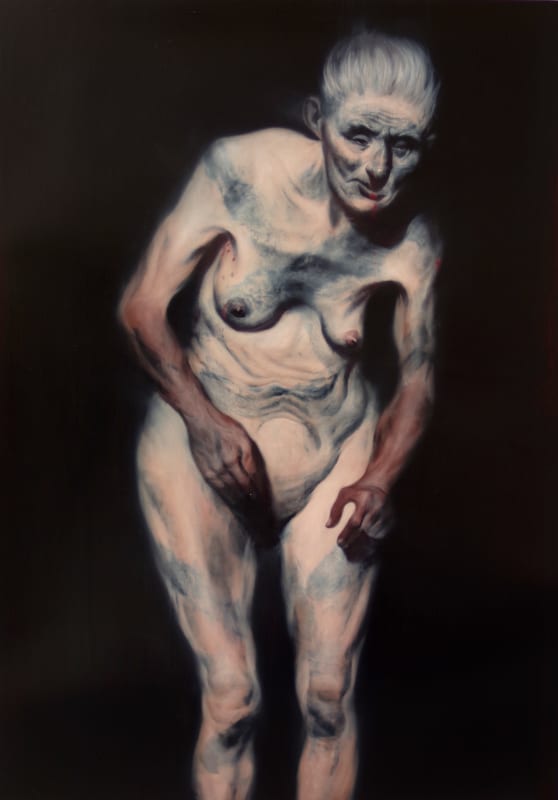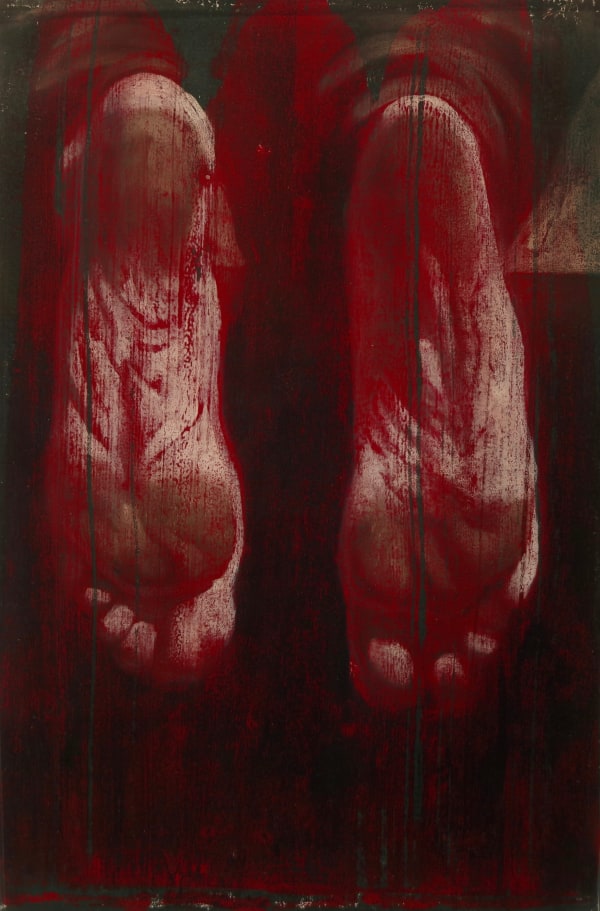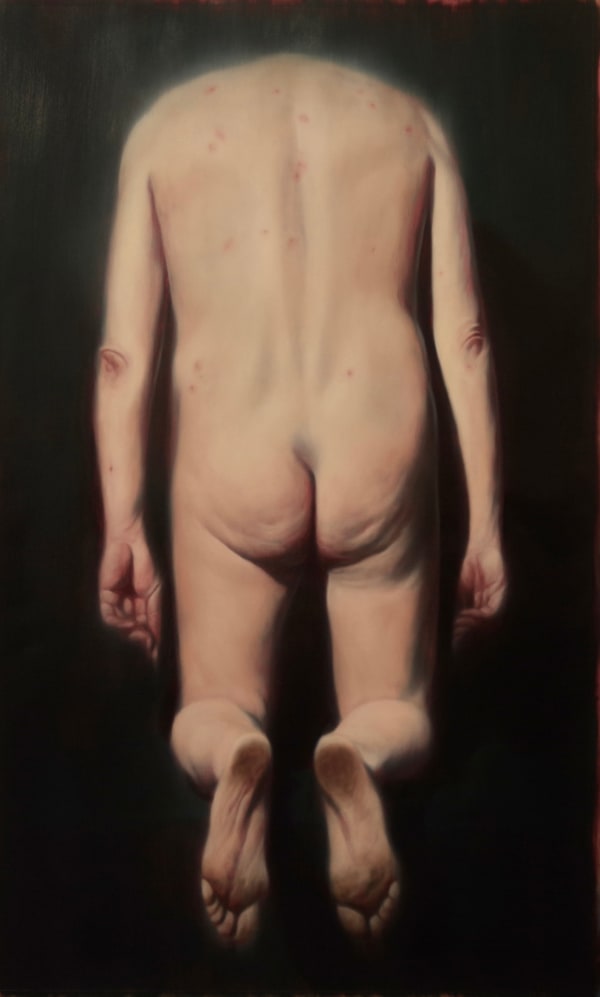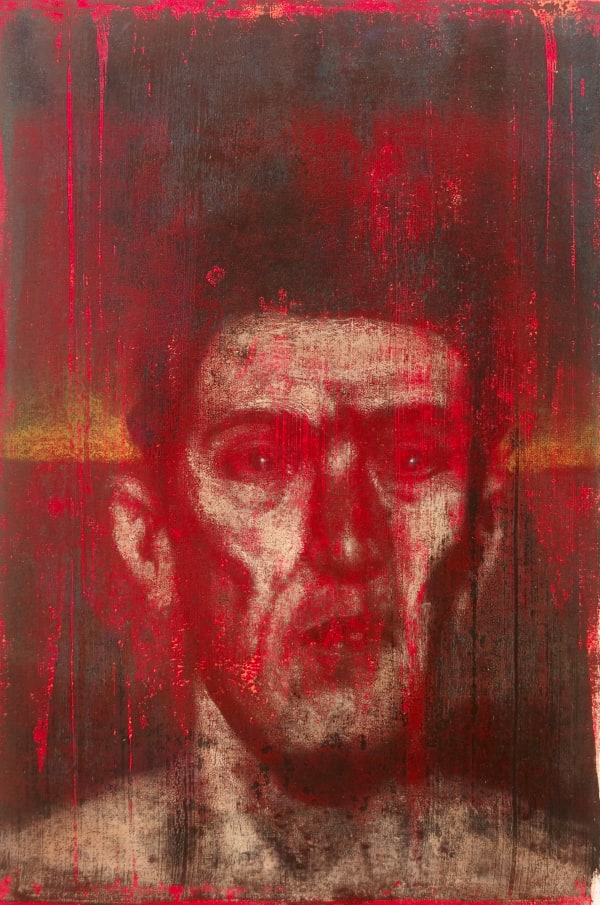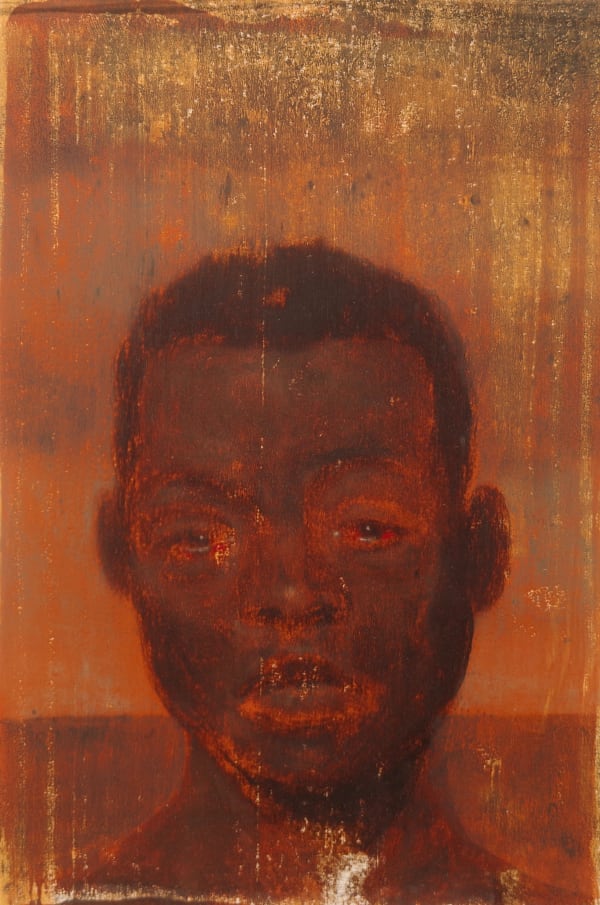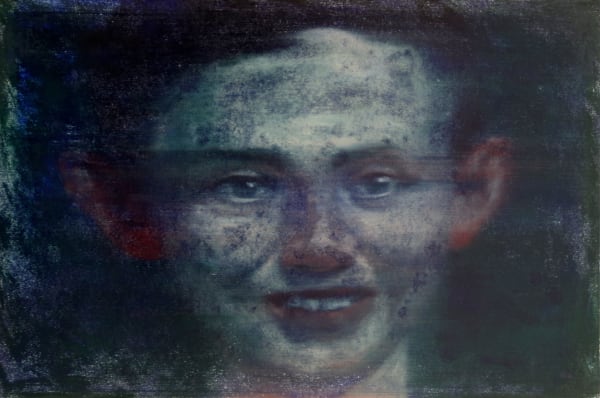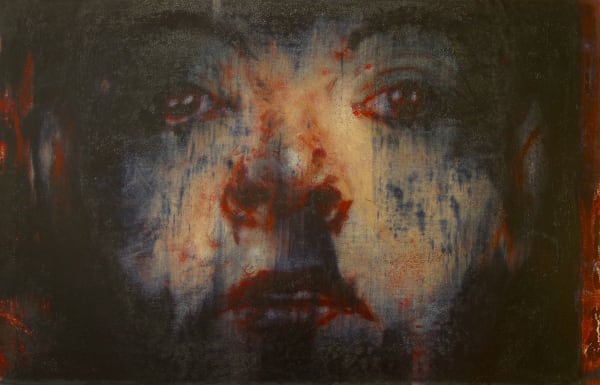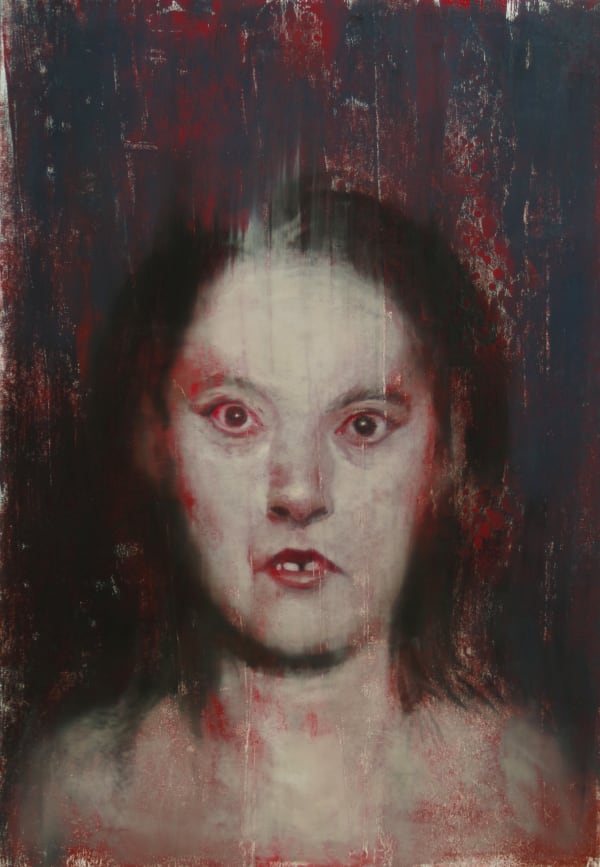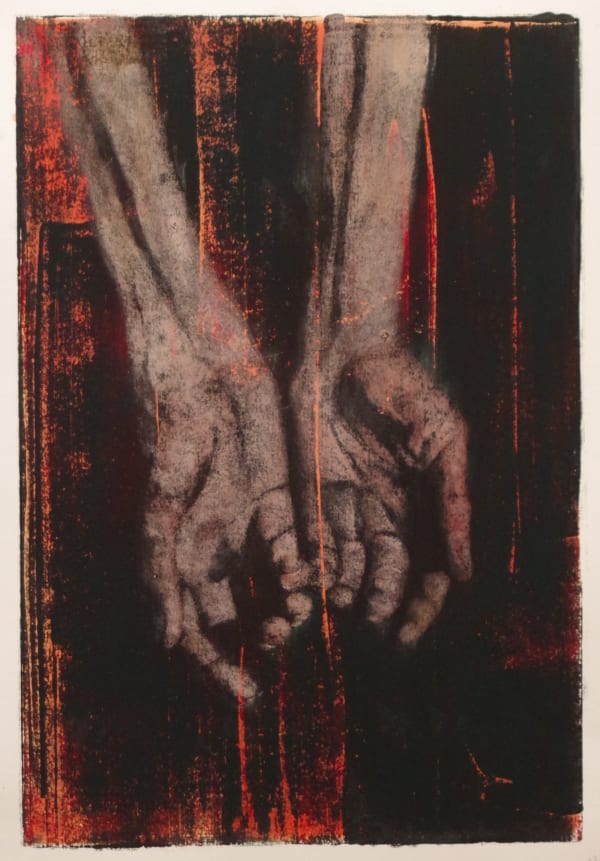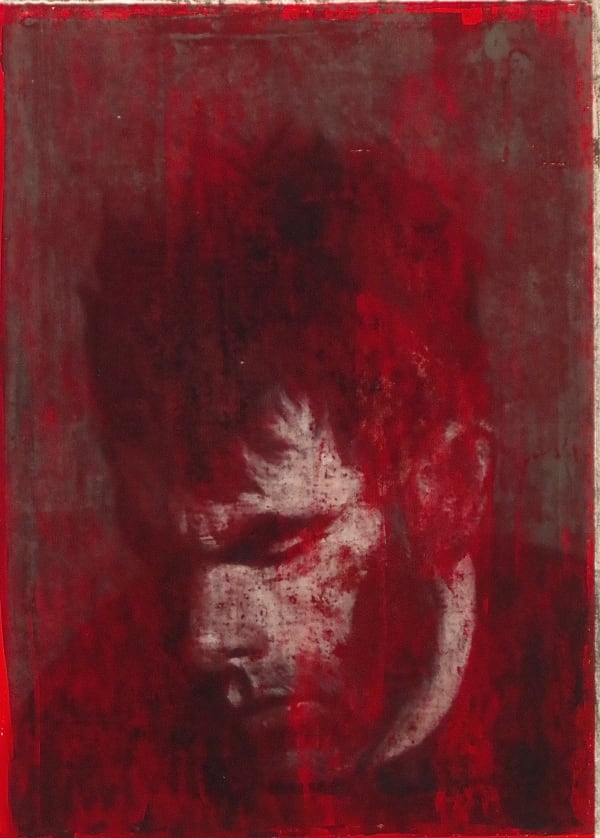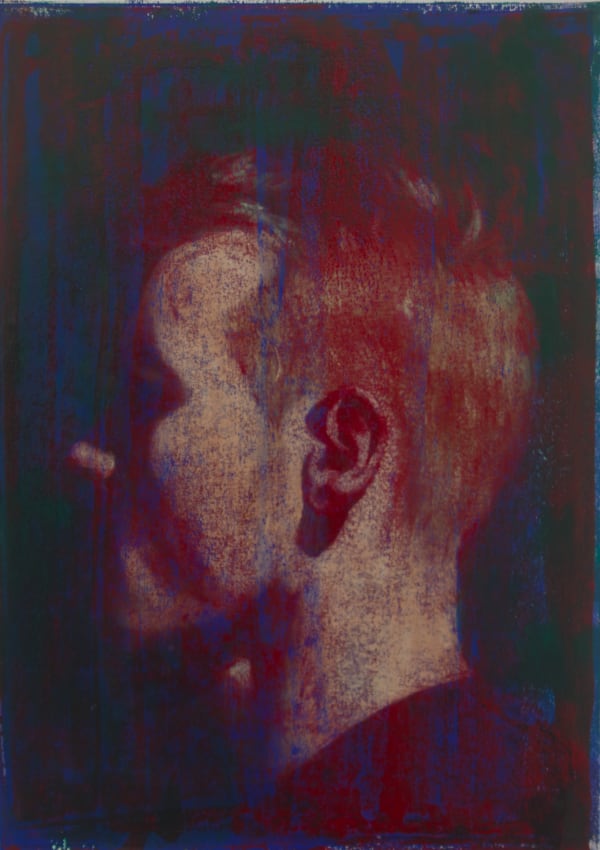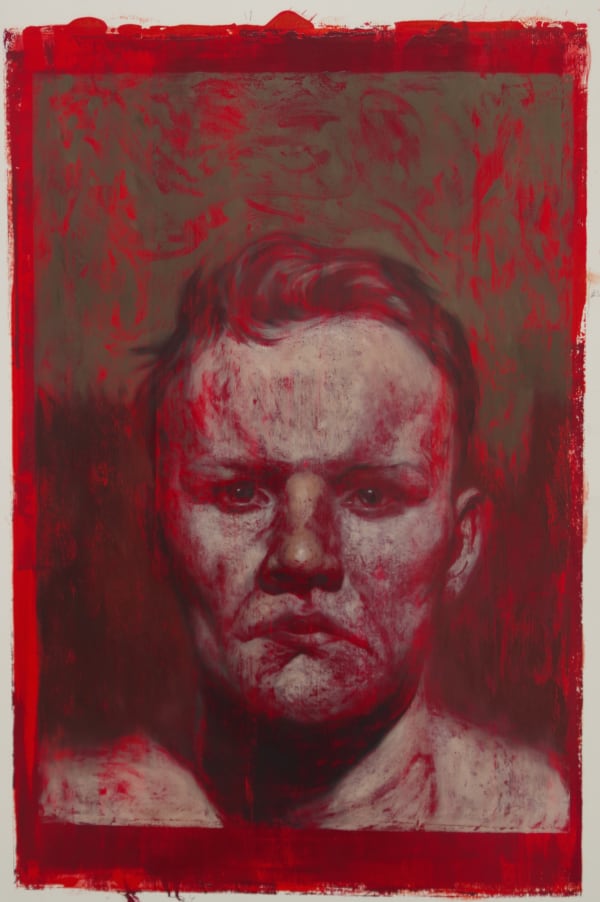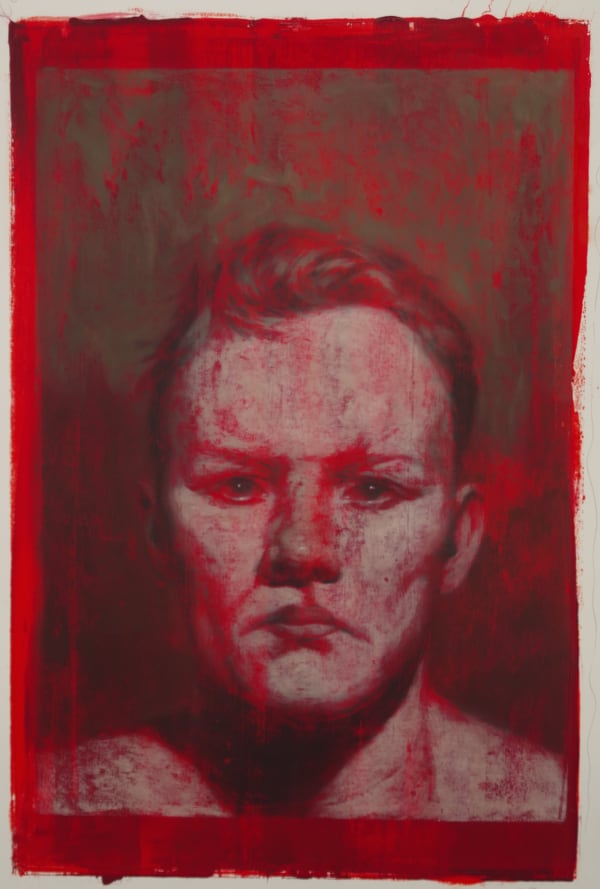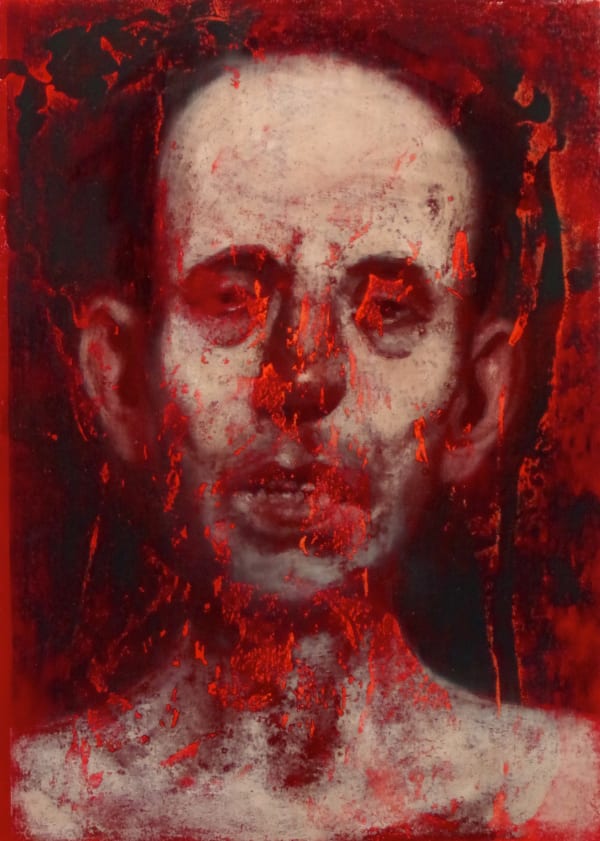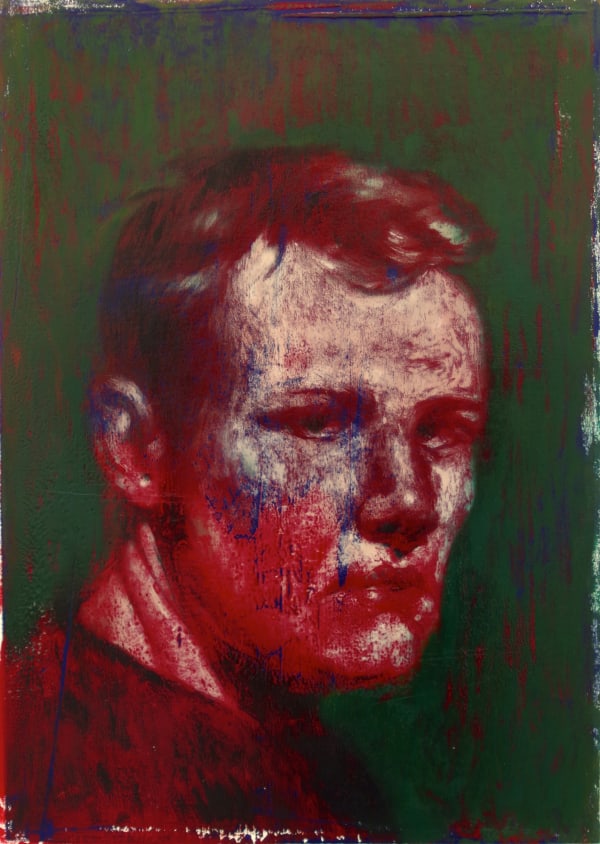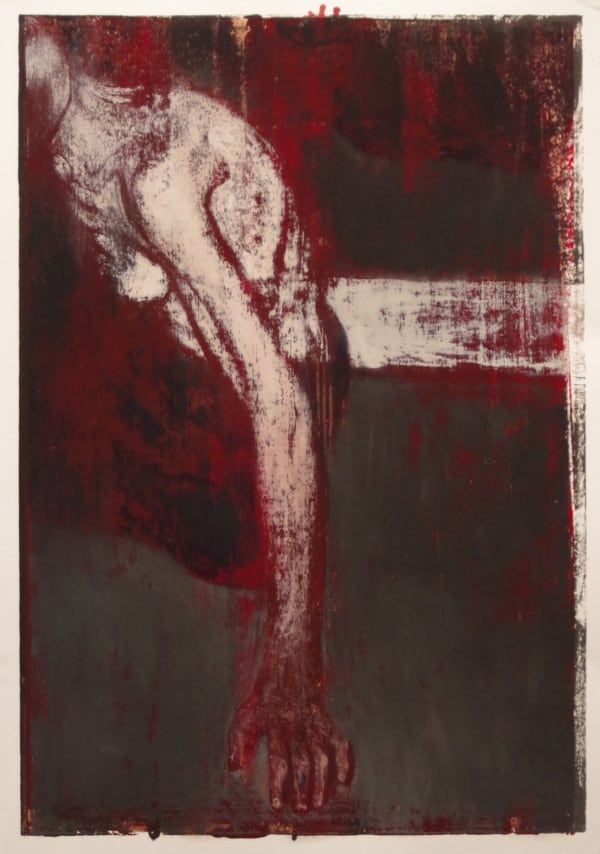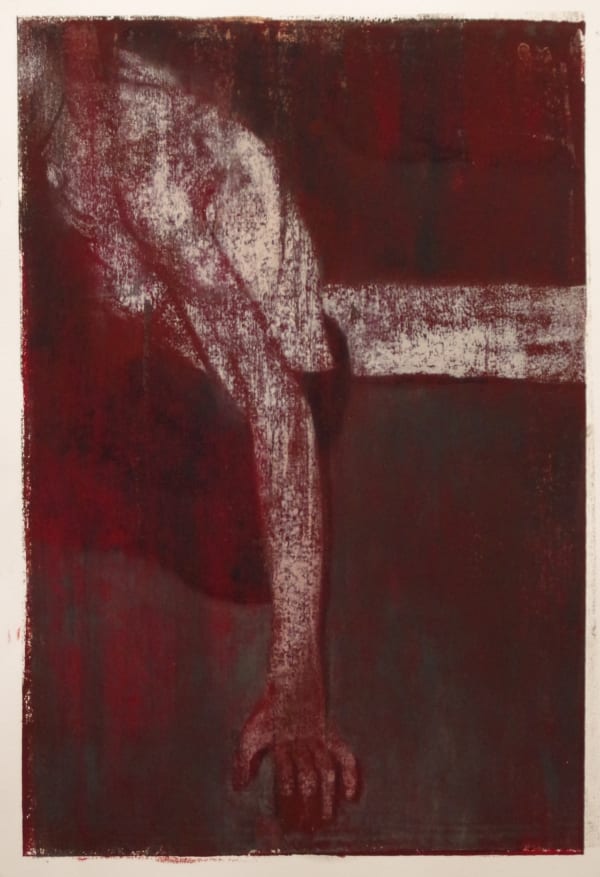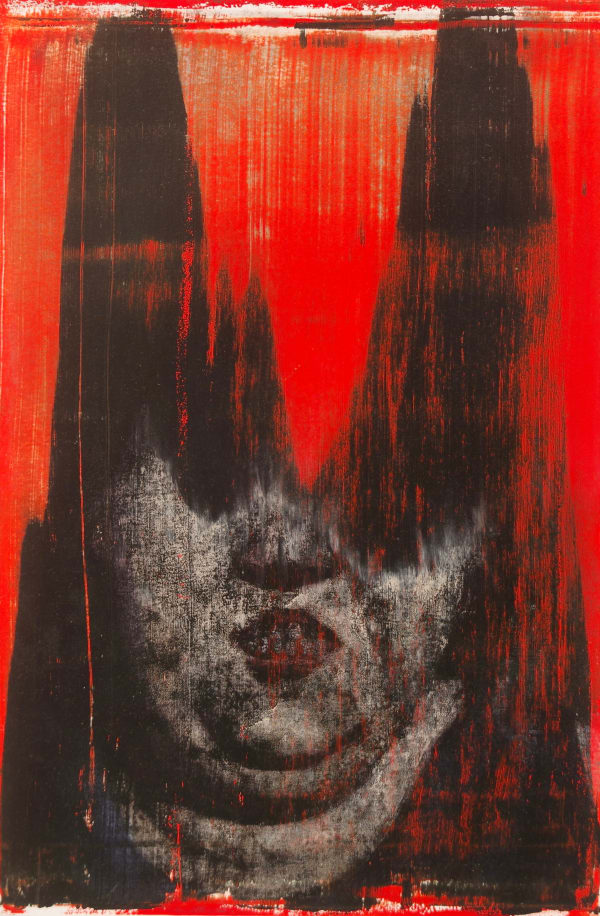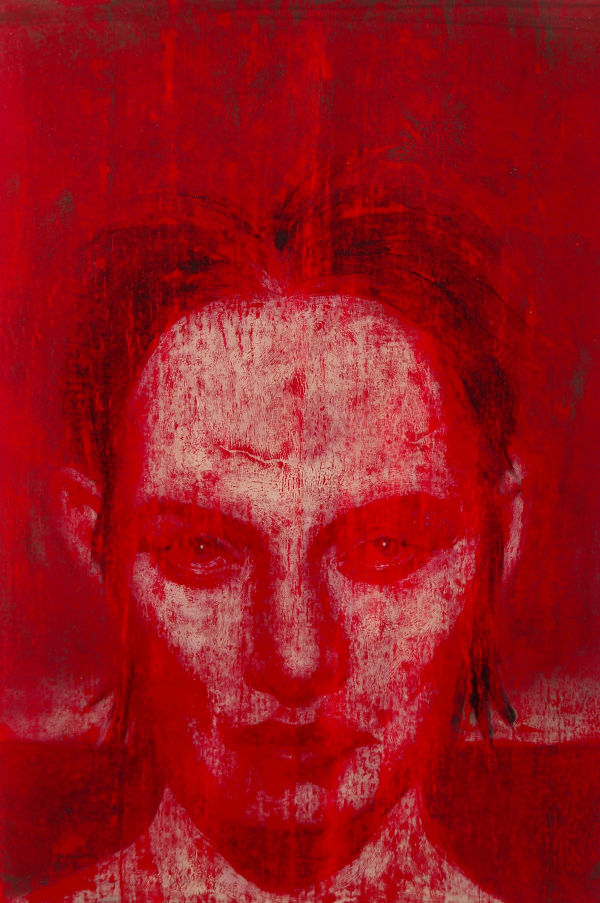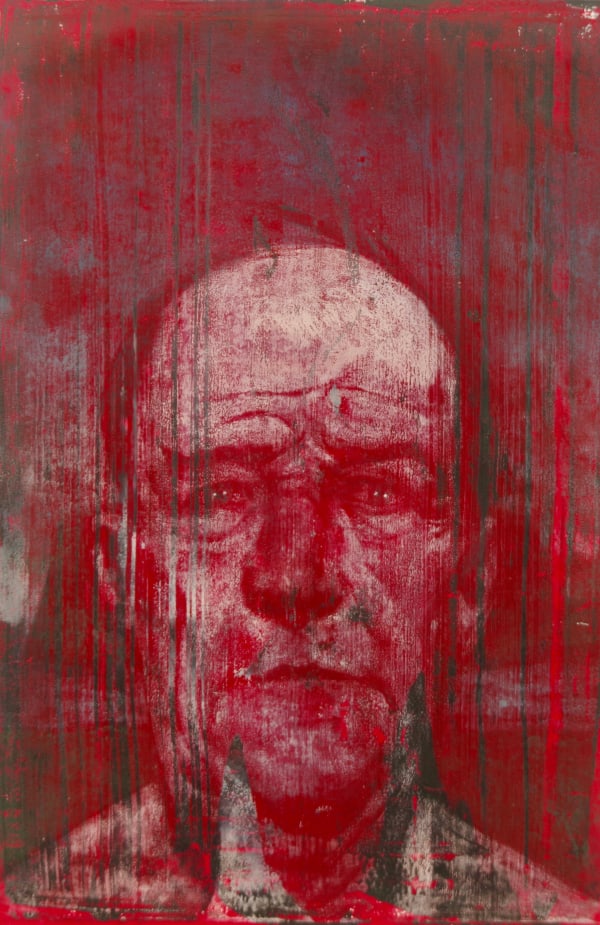Ken Currie: Chunnacas na mairbh beò (The Dead Have Been Seen Alive): First Floor Gallery
Glasgow Print Studio is pleased to present Chunnacas na mairbh beò (The Dead Have Been
Seen Alive), an exhibition primarily of new monotypes by renowned Scottish artist Ken Currie.
The title of this exhibition is taken from Sorley MacLean's 'Hallaig', a poetic response to the
Clearances on the Isle of Raasay. "the dead have been seen alive" is an evocative, mysterious
and haunting line which is open to speculation.
Seven years since his last solo exhibition at Glasgow Print Studio, Ken Currie has been developing this new body of work ever since. Inspired by and propelled by the printmaking techniques which Currie studied and began to master in 2015, this exhibition is composed of a series of figures broadly influenced by the study of Egyptian Funerary portraits from AD 40-250.
Frozen in time like photographs, these ancient and remarkable images are unique, extraordinarily beautiful artefacts which have, for many years, fascinated and haunted Currie.
Here, Currie invites the viewer to draw their own conclusions about who the figures in his
monotypes might be and how they came to be depicted by Currie. Like the funerary portraits of AD 40-250, the heads and figures in Currie's monotypes appear ghostly and distressed. Currie achieves this through the particular technique he has employed, developed over many years of experimentation. Currie paints quickly and broadly onto a copper plate in oils after building up layers of printing ink onto paper, with each layer taking several weeks to dry. The first print (or 'pull' in printmaking terms) is usually disregarded or scrapped, it is the second or third in which he achieves the desired effect, these are known as 'ghosts'.
"I allow a maximum of three imprints from one plate - an initial imprint, a ghost, or cognate, and a second ghost. These are usually imprinted on grounds that have been built up over a period of weeks in different layers. Each imprint can be worked on and manipulated after printing but only up to a point as too much of this will make it cease to be a monotype and more like a painting.
Knowing when to stop can be difficult. The important thing is that after the three imprints are taken the painted image on the plate is wiped away with turps so it ceases to exist except as a series of unique imprints on paper. The failure rate is very high but when it all comes together the results can be compelling."
For Currie, making prints is always a learning process; an exploration of possibilities in the
medium. "There's a lot of experimenting with a lot of successes and a lot of failures. The rate of attrition is enormous. For every ten prints pulled, only one or two make the final cut."

Ken Currie’s long association with Glasgow Print Studio goes back to the early 80s. However it was only in 1992 that he undertook any major printmaking work at the studio, when he produced a series of 27 etchings called The Age of Uncertainty. This was exhibited, to great acclaim, at Glasgow Print Studio that same year. However it was only in 1992 that he undertook any major printmaking work at the studio, when he produced a series of 27 etchings called The Age of Uncertainty. This was exhibited, to great acclaim, at Glasgow Print Studio that same year.
Also included in the exhibition are works on paper in oils which make a connection between the printed images in the monotypes and the process of painting directly onto paper.
Currie was born in 1960, and studied at the Glasgow School of Art from 1978 - 1983. He rose to
attention as one of the New Glasgow Boys along with Peter Howson, Adrian Wisniewski and the late Steven Campbell who studied together at the Glasgow School of Art. Currie is renowned for his unsettling portrayal of the human figure, often created as a response to brutality and suffering in contemporary society. He is well known for his public murals commissioned for the People’s Palace in Glasgow, as well as his enduringly popular artwork from the Scottish National Portrait Gallery Collection Three Oncologists, representing a life-long study of the fragility of the human condition. His large-scale portrait of preeminent forensic anthropologist Professor Dame Sue Black went on view at the Scottish National Portrait Gallery in May 2021.
Currie has exhibited widely internationally, including a solo exhibition at the Scottish National
Portrait Gallery; and has been selected for numerous group shows including The Scottish
Endarkenment: Art and Unreason, 1945 to Present at Dovecot Gallery, Edinburgh, 2016; Reality, Modern & Contemporary British Painting at The Sainsbury Centre for Visual Arts, Norwich and Walker Art Gallery, Liverpool; and Drawing Breath, a touring exhibition marking ten years of the Jerwood Drawing Prize. His work is in the collections of Yale Centre for British Art, Connecticut; Tate, London; Scottish National Gallery of Modern Art, Edinburgh; New York Public Library; Imperial War Museum, London; Gulbenkian Foundation, Lisbon; Campbelltown City Bicentennial Art Gallery, Australia; British Council, London; Boston Museum of Fine Art; and ARKEN, Museum of Modern Art, Copenhagen.
-
 Ken Currie, One Hundred Years, 2017
Ken Currie, One Hundred Years, 2017 -
 Ken Currie, Actor, 2022
Ken Currie, Actor, 2022 -
 Ken Currie, Making a Monotype, 2022
Ken Currie, Making a Monotype, 2022 -
 Ken Currie, Woman with a Necklace, 2022
Ken Currie, Woman with a Necklace, 2022 -
 Ken Currie, Woman in Love, 2022
Ken Currie, Woman in Love, 2022 -
 Ken Currie, Seven Women 1, 2022
Ken Currie, Seven Women 1, 2022 -
 Ken Currie, Seven Women 2, 2022
Ken Currie, Seven Women 2, 2022 -
 Ken Currie, Seven Women 3, 2022
Ken Currie, Seven Women 3, 2022 -
 Ken Currie, Seven Women 4, 2022
Ken Currie, Seven Women 4, 2022 -
 Ken Currie, Seven Women 5, 2022
Ken Currie, Seven Women 5, 2022 -
 Ken Currie, Seven Women 6, 2022
Ken Currie, Seven Women 6, 2022 -
 Ken Currie, Seven Women 7, 2022
Ken Currie, Seven Women 7, 2022 -
 Ken Currie, Man Collapsing, 2017
Ken Currie, Man Collapsing, 2017 -
 Ken Currie, Shoeless, 2022
Ken Currie, Shoeless, 2022 -
 Ken Currie, Standing Figure, 2016
Ken Currie, Standing Figure, 2016 -
 Ken Currie, Standing Figure (Ghost), 2016
Ken Currie, Standing Figure (Ghost), 2016 -
 Ken Currie, Study (Supplicant), 2022
Ken Currie, Study (Supplicant), 2022 -
 Ken Currie, The Dead Have Been Seen Alive, 2022
Ken Currie, The Dead Have Been Seen Alive, 2022 -
 Ken Currie, Starving Argonaut, 2022
Ken Currie, Starving Argonaut, 2022 -
 Ken Currie, The Egyptian, 2022
Ken Currie, The Egyptian, 2022 -
 Ken Currie, The Young Henry, 2016
Ken Currie, The Young Henry, 2016 -
 Ken Currie, Encounter, 2018
Ken Currie, Encounter, 2018 -
 Ken Currie, Apparition, 2016
Ken Currie, Apparition, 2016 -
 Ken Currie, Give and Take, 2018
Ken Currie, Give and Take, 2018 -
 Ken Currie, Guga Hunter, 2017
Ken Currie, Guga Hunter, 2017 -
 Ken Currie, Guga Hunter (Ghost), 2017
Ken Currie, Guga Hunter (Ghost), 2017 -
 Ken Currie, Head and Ground, 2017
Ken Currie, Head and Ground, 2017 -
 Ken Currie, Head in Profile, 2015
Ken Currie, Head in Profile, 2015 -
 Ken Currie, Head of a Woman, 2015
Ken Currie, Head of a Woman, 2015 -
 Ken Currie, Hindsight, 2018
Ken Currie, Hindsight, 2018 -
 Ken Currie, How Much Longer Must we Wait, 2017
Ken Currie, How Much Longer Must we Wait, 2017 -
 Ken Currie, How Much Longer Must we Wait (Ghost), 2017
Ken Currie, How Much Longer Must we Wait (Ghost), 2017 -
 Ken Currie, Inferno, 2018
Ken Currie, Inferno, 2018 -
 Ken Currie, Likeness of the AC, 2015
Ken Currie, Likeness of the AC, 2015 -
 Ken Currie, Limb, 2016
Ken Currie, Limb, 2016 -
 Ken Currie, Limb (Ghost), 2018
Ken Currie, Limb (Ghost), 2018 -
 Ken Currie, Masque, 2022
Ken Currie, Masque, 2022 -
 Ken Currie, Revenge, 2022
Ken Currie, Revenge, 2022 -
 Ken Currie, River Man, 2022
Ken Currie, River Man, 2022 -
 Ken Currie, Salt Road, 2022
Ken Currie, Salt Road, 2022 -
 Ken Currie, Self Portrait, 2017
Ken Currie, Self Portrait, 2017 -
 Ken Currie, Cries and Whispers 1, 2 & 3, 2022
Ken Currie, Cries and Whispers 1, 2 & 3, 2022
